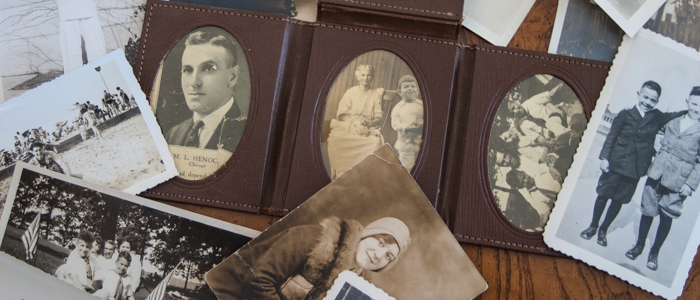Saving Family Treasures
By Vivian Henoch, Editor myJewishDetroit
April 1, 2014
By Robbie Terman, Archivist, Leonard N. Simons Jewish Community Archives
It’s that time of year again, when the snow (slowly!) begins to thaw, and we venture into basements, closets and drawers on a spring cleaning binge. This may mean dealing with boxes of documents and photographs you’ve successfully avoided for years, or uncovering treasures long forgotten.
Instead of closing the door on these items for another year, get them organized now with this DO and DON’T guide to preservation.

Documents and Papers
Our homes are filled with documents that have not only sentimental value, but also historic value. From correspondence, diaries, scrapbooks, and genealogy documents to the handwritten recipe of your great-grandmother’s noodle kugel. Paper items will deteriorate over time, but it is how we treat them which will determine how quickly.
DO store your records in acid-free folders and boxes.Why? Because paper has a high acid content and is extremely susceptible to moisture and temperature fluctuations which can cause materials to expand and contract, contributing to deterioration. Professional archival folders and boxes can stabilize and protect documents over long periods of time. Boxes also provide protection from light, pests, pollutants and water. When purchasing supplies, beware of big box stores that claim “archival quality” supplies. They don’t necessarily conform to any archival standard. Mail order companies, such as Hollinger Metal Edge and Gaylord Brothers, are who professionals use.
DO separate documents, such as news clippings, that discolor easily. Or, you may want to consider photocopying news clippings and discarding the original. Items such as these are highly contaminant and will “off-gas” — a process that is harmful to the other documents in the box.
DON’T do anything that cannot be reversed, such as punch holes in documents, mark them with permanent ink or marker, laminate, or glue or tape documents. Remove metal fasteners that can rust and stain documents.
DO store boxes in a stable environment. This means a location with steady temperature and humidity. The ideal environment is 60-70 degrees Fahrenheit and 40-50% relative humidity. If that is not a possibility, then there should at least be air-conditioning in the summer and heat in the winter. Also, keep boxes out of basements, garages and attics, where it is harder to control temperatures, and where there is an increased risk of pests, water and mold. If you must store your collection in the basement, make sure you lift it six inches off the ground in case of a flood.

Photographs
Like a document, a photograph’s longevity rests on how it’s treated.
DO your research before buying a photo album. Most inexpensive albums are made using PVC plastics which generate acids that erode photographs over time. Instead, look for plastic enclosures made from uncoated pure polyethylene, polypropylene or polyester, which are stable and non-damaging to photographs.
DON’T use self-stick albums. Besides the adhesive discoloring the photograph over time, it can become overly tacky, making it difficult to remove the photograph without damage. Instead, use an album with non-acidic, lignin-free paper.
DON’T attach photographs using glue or tape which can fail over time or become difficult to remove. It also increases the probability of fading and discoloration. Instead, use photo corners.
DO consider storing photographs in acid-free, lignin-free sleeves and keeping them in flat acid-free boxes.
DO caption photographs on the back with a soft lead pencil. If the paper is resin-coated, you can use a felt-tip, fine-point marker (DON’T use a ball-point pen, which can cause an indentation). Allow the ink to dry before stacking it on another photo, and check to make sure the ink doesn’t bleed through (writing softly on the edge works best).
DO store your photographs in the coolest and driest spot in your home that stays that way year round. Finished basements are frequently cool, but they are usually too damp for photo storage unless they are dehumidified. Dampness should be avoided as it causes photos to stick together and promotes mold growth. Above ground interior closets maintain fairly consistent temperatures throughout the year and are suitable for storage.
DO reproduce fragile photographs for display and keep the original safely stored. You also may want to scan photographs so that you have a back-up in case of a disaster.
If you find that you don’t have access to the right materials, or optimal storage, you may want to consider donating your papers to an archive. A good archive will not only be able to provide proper storage, it can arrange the collection in an easily-accessible order. Best of all, you’ll know your family’s history will be around for centuries to come!



